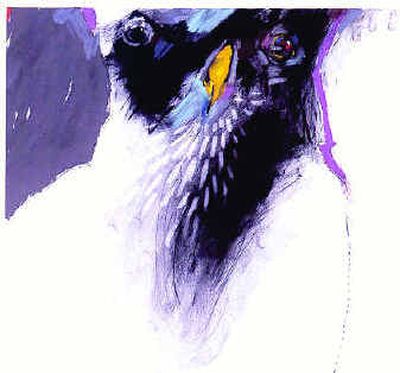Multicultural canvas

If you want to see stereotypical western and Native American art, then “Rick Bartow: My Eye” is not for you.
Yes, Bartow has Native American heritage. In 1911 his Wiyot grandfather, of the Mad River Band, walked 300 miles from northwestern California to the central Oregon coast and settled on land where Bartow and his family still live.
Yes, his images draw inspiration from various Native American stories and symbols.
However, the 52 pieces on view at the Northwest Museum of Arts and Culture also illustrate influences from German expressionism, African sculpture, Maori culture, Japanese kanji and the Bible.
Bartow, 57, will be at the museum on Friday at 6 p.m. to talk about his drawings, paintings, prints, masks and sculptures.
“Bartow is very eclectic,” said Jochen Wierich, museum art curator. “Whether it’s Native American, Pacific Rim or European traditions, he has no boundaries. He takes it all in and makes something new out of it.”
Bartow, according to Charles Froelick, owner of the Froelick Gallery in Portland, is both prolific and proficient in expressing a broad range of thoughts and emotions.
“Rick is an exception draftsman and storyteller,” said Froelick. “He loves to draw what he sees and is excellent at making a narrative visual.”
The work in this mid-career retrospective reflects Bartow’s vision as it has grown from his life experiences and the connections he maintains with other artists and various art traditions., said exhibit curator Rebecca Dobkins of the Hallie Ford Museum of Art in Salem, Ore.,
“But,” said Dobkins in a recent telephone interview, “if someone is associating him with what a simple notation of what a Native American artist is, they are going to be surprised. Much of his work is very raw.”
Pivotal to Bartow’s art was his Vietnam experience and its aftermath.
“Rick’s work covers a range of human experiences including grief and fear,” said Dobkins. “In an age where people are struggling with what it means to be human, he is able to bring together these elements and often creates great beauty. That’s very powerful.”
Transformation is theme
“If you study my work,” said Bartow from his studio in South Beach, Ore., “you can usually see a number of things peeking out.”
There are transformative images of animals becoming human, of growling bears, leaping frogs and screaming, tormented souls.
“Within what is often a complex and expressive piece, however,” says Wierich, “there is a directness of style.”
Bartow said his process of making art is simply starting with a mark.
“It is very intuitive,” he said. “I just grab colors out of a box and smear things around. Then I go back in and refine until I start coming up with something.”
The expressive drawing “Big Owl for JBF,” recently purchased by the MAC for its permanent collection, was created this way. It started with a strong mark and grew to include a swash of bold color, a large field of white space and an animal’s piercing gaze.
“He lays down raw emotions,” said Froelick , “and it is expressed in gestural ways like rubbing pastel into the paper and scratching it with graphic pencil.”
Rather than trying to make every single detail of the owl, Bartow focused on the powerful eyes.
The impetus for this narrative piece, recalled Bartow, came from a walk one night in New Zealand with John Bevan Ford, a leader in contemporary Maori art.
“John and I were walking along a dense, forested path and an incredible full moon had just popped up,” he said. “I was recalling how in our ceremonies we have this song for the Grandmother moon and I began to sing it.
“All of sudden out of darkness in the jungle came this incredible bird call that absolutely put tears in my eyes. John grabbed my arm and said, ‘The Spirits are acknowledging you.’
“The bird just sang that once and stopped. It was a very touching moment.”